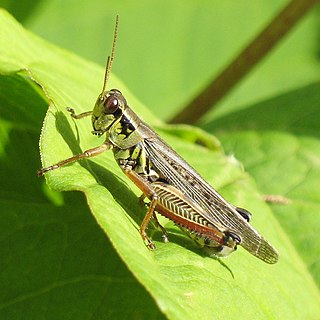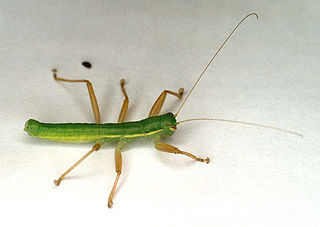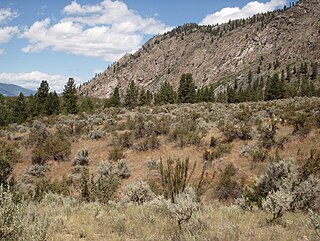
Grylloblattidae, commonly known as the icebugs or ice crawlers, is a family of extremophile (psychrophile) and wingless insects that live in the cold on top of mountains and the edges of glaciers. It is the only member of Grylloblattodea, which is generally considered an order. Alternatively, Grylloblattodea, along with Mantophasmatodea, have been ranked as suborders of the order Notoptera. Grylloblattids are wingless insects mostly less than 3 cm long, with a head resembling that of a cockroach, with long antennae and having elongated cerci arising from the tip of their abdomen. They cannot tolerate warmth and many species have small distribution ranges.

Marys Peak is a mountain in Benton County, Oregon, United States, just southwest of Philomath. According to the Benton County Historical Society, the native Kalapuya called the peak tcha Timanwi, or 'place of spiritual power'. It is the highest peak in the Oregon Coast Range. It is also the highest point in Benton County, and ranks eleventh in the state for prominence.

Melanoplus is a large genus of grasshoppers. They are the typical large grasshoppers in North America. A common name is spur-throat grasshoppers, but this more typically refers to members of the related subfamily Catantopinae.

Grylloblatta chirurgica is a species of insect in family Grylloblattidae. Like other species in the genus, it is endemic to the United States. This species is also known as the Mount Saint Helens grylloblatid, and is found at high elevations and in ice caves in south-western Washington state, especially in Skamania County around Mount St. Helens. It has also been found in the Chinook Pass area of Yakima County.

Grylloblatta is a genus of insects in the family Grylloblattidae. It contains 15 species, including Grylloblatta chirurgica, almost exclusively from high-altitude and high-latitude regions of the United States and Canada, living in ice caves and glaciers.

Notoptera, also known as Xenonomia, is a clade of insects belonging to Polyneoptera. It contains two living groups, Mantophasmatidae (gladiators) native to southern Africa, and Grylloblattidae native to cold montane environments in the Northern Hemisphere. Both groups are wingless.
Oligonicella scudderi, common name Scudder's mantis or slender prairie mantid, is a species of praying mantis native to the southern United States. It is a small brown insect; the males can fly but the females are wingless.

Grylloblatta campodeiformis, also known as the northern rock crawler, is an omnivorous species of insect in family Grylloblattidae. Like other species in the genus Grylloblatta, it is endemic to North America.
Grylloblatta barberi is a North American species of wingless insect in the genus Grylloblatta. It is a rock crawler that lives at high altitudes in crevices under snow or glaciers. It was first described by Andrew Nelson Caudell in 1924.
Grylloblatta chintimini is a species of rock crawler in the family Grylloblattidae. It is found in the state of Oregon in the United States.
Grylloblatta bifratrilecta is a species of rock crawler in the family Grylloblattidae. It is found in North America, including Sonora Pass and Carson Pass in the Sierra Nevada.

South Okanagan—Similkameen National Park Reserve is a proposed national park reserve in the Regional District of Okanagan-Similkameen of British Columbia. The goal of the park is to work with the local First Nations to protect a large patch of Okanagan dry forests and part of the northern reach of the Columbia Plateau ecoregion in Canada.
The paleofauna of the Eocene Okanagan Highlands consists of Early Eocene arthropods, vertebrates, plus rare nematodes and molluscs found in geological formations of the northwestern North American Eocene Okanagan Highlands. The highlands lake bed series' as a whole are considered one of the great Canadian Lagerstätten. The paleofauna represents that of a late Ypresian upland temperate ecosystem immediately after the Paleocene-Eocene thermal maximum, and before the increased cooling of the middle and late Eocene to Oligocene. The fossiliferous deposits of the region were noted as early as 1873, with small amounts of systematic work happening in the 1880-90s on British Columbian sites, and 1920-30s for Washington sites. Focus and more detailed descriptive work on the Okanagan Highlands site started in the last 1970's. Most of the highlands sites are preserved as compression-impression fossils in "shales", but also includes a rare permineralized biota and an amber biota.

Galloisiana is a genus of insects in the family Grylloblattidae found in East Asia. It contains 12 species.
Grylloblatta chandleri is a species of insect in the family Grylloblattidae. Its type locality is an ice cave in Eagle Lake in California, United States.
Grylloblatta newberryensis is a species of insect in the family Grylloblattidae. It is found in central Oregon, United States.
Grylloblatta rothi is a species of insect in the family Grylloblattidae found in Oregon. Its type locality is Happy Valley in Deschutes County, Oregon, United States. It is also known from Mount Hood and Crater Lake.
Grylloblatta siskiyouensis is a species of insect in the family Grylloblattidae. Its type locality is in Oregon Caves National Monument in the United States.
Grylloblatta washoa is a species of insect in the family Grylloblattidae. Its type locality is Echo Summit in the Sierra Nevada of California, United States. Specimens have also been collected in Placer County and Nevada County.

Weygoldtina is an extinct genus of tailless whip scorpion known from Carboniferous period, and the only known member of the family Weygoldtinidae. It is known from two species described from North America and England and originally described in the genus Graeophonus, which is now considered a nomen dubium.










